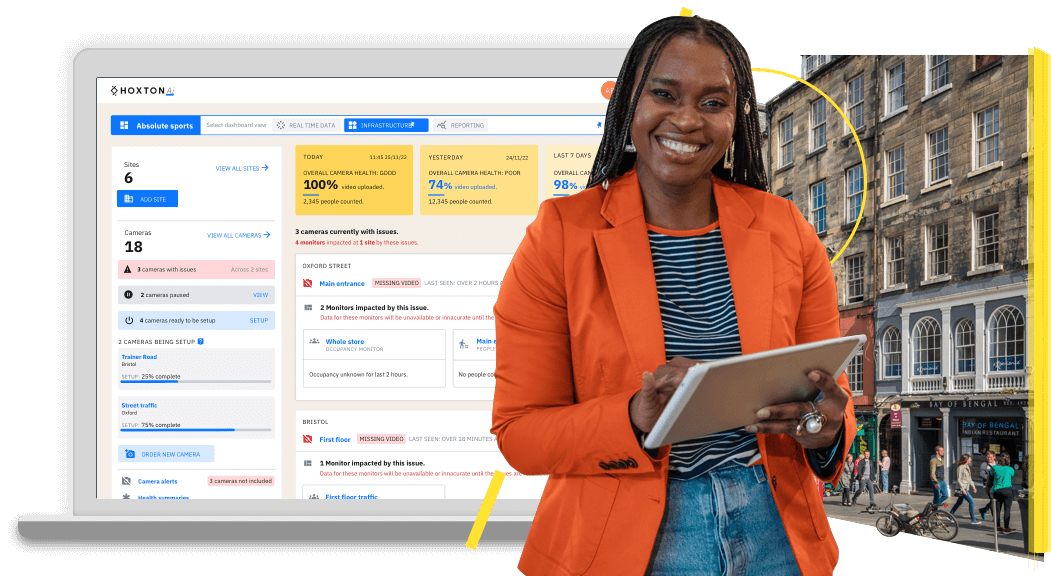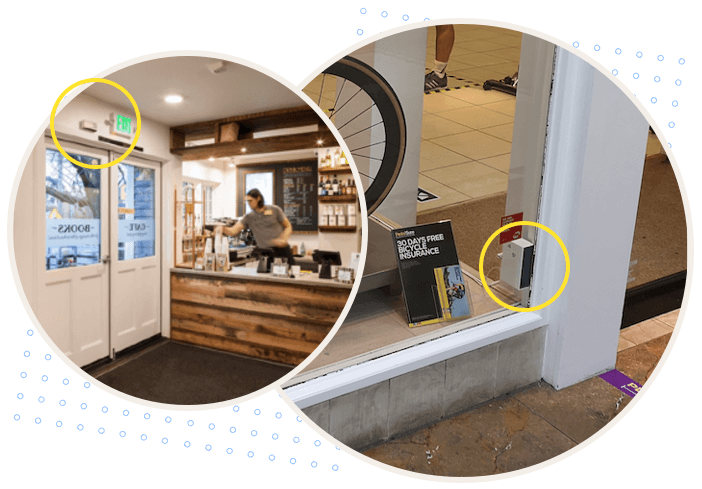What is a conversion rate?
A conversion rate is typically considered to be the percentage of people that make a purchase after entering a store in a given time period. This is the same for both online and physical stores.
Why is conversion important to measure in retail?
Of course, sales is the most important KPI. However, when analyzing store performance it should be noted that looking simply at sales doesn't account for external factors that occur before the sale, such as how many people visit your store, which in many ways dictates your opportunity to sell. For this reason, retailers look at 'conversion rates' to give insight into how well a store is converting people from visitors into paying customers rather than the number, or value, of sales alone.
Tracking conversion, retailers are able to start to consider questions like 'what are the factors that are driving sales?' and 'How can I affect these factors to increase my rate of conversion?'.
There are many ideas on how to increase conversion in physical retail stores, but from our experience working with hundreds of clients to make the best use of their footfall data, we put together the following article: How to use Footfall Analytics to Improve Store Performance
.png?width=500&height=445&name=horiz-overhead-traff-backround%20(1).png)
The formula for calculating a conversion rate (with example)
Firstly we set a time period, whether it be yesterday, the last 30 days, or last year, it's important to be clear about what time period you're working over. Then, if we call the total number of people who enter the store in our time period 'visitors' and those who go on to make a purchase 'buyers'. A conversion rate can be calculated using the following formula:
Conversion Rate = 100 * ( buyers / visitors )
An Example
Say Natasha, Retail Director at 'Sustainable Candles R Us', is looking increase revenue by putting on a sales workshop for either her Covent Garden or Kings Road branch. Looking at the sales data she sees the revenue and profits of each branch happen to be identical! Enlightened and inspired after reading an article on conversion rates, she has decided to calculate and compare the branches conversion rates to give an insight as to which branches might be performing better.
Firstly, she decides due to changes in staff at one of the branches it would be sensible to consider the conversion rates of the stores over the last two weeks. After retrieving the relevant numbers for the Covent Garden (587 buyers, 8874 visitors) and Kings Road (107 buyers, 983 visitors) branches, she pops them into our handy formula.
Covent Garden Conversion Rate = 100 * ( 587 / 8874 ) = 6.61% (2DP)
Kings Road Conversion Rate = 100 * ( 107 / 983 ) = 10.89% (2DP)
As we can see, although the sales data for the two stores happens to be identical, the conversion rate of the Kings Road store is almost double that of the Covent Garden store over the two weeks. This means a higher proportion of the people who visited the Covent Garden store over the two weeks did not go on to make a purchase. Although this doesn't necessarily imply sales staff are performing worse at this branch (as there could be many other factors at play), it can still give Natasha useful insight into choosing where to run her workshop.
In this case, Natasha has determined that it was in fact the sales staff performance affecting conversion and she decides to run the workshop at the Covent Garden Branch.
Measuring Conversion in a brick and mortar store
In the world of e-commerce, measuring conversion is simple. The number of visitors your store receives, and the number of buyers you have is often tracked by default. Then various retail metrics are calculated automatically... But how does this work for a physical store?
How to measure footfall in a physical store
If you are an independent, low-footfall store then it may be possible to keep track of the number of people who visit your store using a simple tally or using a clicker counter. That being said, these methods leave a lot of room for human error, bias, and costs incurred in employee time. In our experience, even on a small scale, manually counting is inefficient and rarely gives people high-quality data upon which to base important operational decisions.
For retailers with multiple stores, the problem becomes even more complex. This is why since the 1990s retailers have been using automated 'people counting solutions' to track in-store footfall and ensure they're able to leverage insights from understanding conversion across their portfolio (to learn more check out our 'Introduction to People Counting in Retail').
Moreover, recent advances in artificial intelligence has meant that accessing this kind of technology is now easier than ever. Now boasting lower costs, higher accuracy, and deeper insights. If you're interested in making use of an automated people count system, we'd love for you to contact us to see if we could help you with what you're looking to achieve.
Measuring the number of sales
Most retailers are now using a modern Electronic Point of Sale (EPOS) system, which makes, among many things, retrieving data on sales over a time period a breeze. That being said, those retailers who are not using an EPOS will still be tracking the number of sales as well as their value for obvious reasons, so retrieving this data should still be fairly easy.

Summary
Here we've discussed what exactly conversion rates are, and how they are used by retailers to gain insights into how well their store is converting visitors into paying customers. We then explored an example, highlighted the importance of measuring footfall in physical stores and spoke about how automated people-counting solutions can be used to track conversion accurately. We wish you the best in your onward retail metrics journey and hope to hear from you soon.
Recent Articles
How real-time footfall data helped a Telco Franchisee drive a 20% increase in revenue
Duncan Mann | Oct 2024
Background: the importance of sales conversion rate
Read moreCase Study: How fashion retailer GOOD uses the HoxtonAi Retail Report to improve accountability and increase conversion across their stores.
Owen | Jun 2023
“The retail report has been a game-changer. Each week, we discuss the footfall and conversion ...
Read moreOn the accuracy of retail footfall counters
Owen | May 2023
In retail, footfall-related metrics have become cornerstone data points used to track various ...
Read moreThe OKR goal setting framework: how to drive success in retail
Owen | Apr 2023
At HoxtonAi, we speak to hundreds of retailers about their store management, data requirements and ...
Read moreHow combining different types of footfall data can build a digital view of physical stores
Owen | Apr 2023
One of the biggest differences between optimization in online and physical retail spaces is the ...
Read moreWhy footfall isn't the end-all. What to do about the retail data gap.
Owen | Apr 2023
In our experience, we’ve found that most retailers are familiar with the idea of monitoring ...
Read moreThe Main Challenges for Retailers in Fully Leveraging Footfall Data
Owen | Mar 2023
In today's digital age, data has become a valuable asset for businesses looking to optimize their ...
Read moreWhat We Talk About When We Talk About Retail Footfall
Owen | Mar 2023
The soft side of cold, hard data We’ve released content on the ‘hard’ aspects of using data to ...
Read moreTop 6 Essential KPIs & Metrics in Retail
Owen | Mar 2023
As retail technology has evolved, we have found better ways to measure, track and compare ...
Read moreWhat is Conversion in Retail? And How to Measure it in a Physical Store?
Owen | Mar 2023
What is a conversion rate? A conversion rate is typically considered to be the percentage of people ...
Read moreHow to use Footfall Analytics to Improve Store Performance
Duncan Mann | Mar 2023
Before we get started, for a quick reminder of what 'people count' and 'footfall' mean, check out ...
Read moreWhat We've Found Analysing Footfall Data in Retail
Duncan Mann | Mar 2023
5 Trends We've Noticed... "At HoxtonAi, we work with customers to ensure their data is high ...
Read moreClosing the data gap between online and physical retailing
Owen | Mar 2023
As shoppers continue to return to the high street post-pandemic, physical stores need to catch up ...
Read moreAn Introduction to People Counting in Retail
Owen | Mar 2023
What is people counting? Simply put, people counting is the act of counting the number of people ...
Read moreCase Study: How Center Parcs Use Occupancy Data To Drive Better Guest Experiences.
Duncan Mann | Aug 2022
We initially trialled the HoxtonAi solution on a small scale to ‘kick the tyres’ and see if it’s a ...
Read more